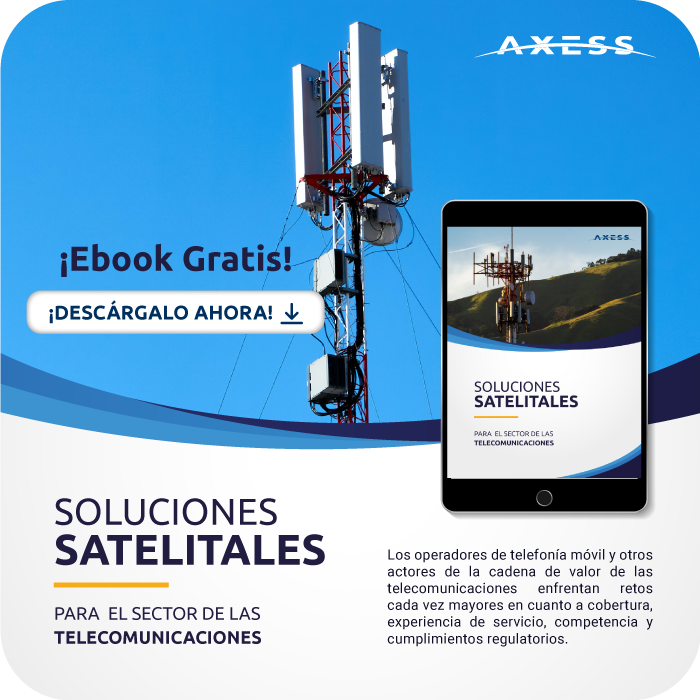
Communication Satellites
19 May, 2022
AXESS Success Stories: The challenge: Connecting the unconnected with WOM Colombia
7 June, 2022For some time now, the term Internet of Things (the Internet of Things or simply IoT) has been very present today, which has substantially increased the number of manufacturers that launch devices onto the market oriented to this topic. But what really is the internet of things?
When we talk about the internet, what we do is talk about the interconnection network between the different computers worldwide. Well, the so-called internet of things is nothing more than a digital interconnection network between devices, people and the Internet itself, which allows for the exchange of data between them, in such a way that key information about use and performance of the devices and objects can be captured to detect patterns, make recommendations, improve efficiency, and create better experiences for users.
Currently, there are seemingly limitless connectivity options for IoT projects, for which is why satellite networks are being used to provide the necessary connectivity.
In order to create a satellite-enabled IoT solution, the devices integrate a satellite IoT modem into their product, allowing customers to connect to the satellite network. Depending on the IoT solution architecture and value chain, the device may offer a user panel with IoT data or use a white-label solution from the network provider or third party.
GEO-satellites
Naturally, all satellites use orbits, which can be as high as thousands of kilometers above the Earth’s surface (GEO Geostationary Orbit), up to hundreds of kilometers (LEO Low Earth Orbits).
Massive GEO satellites sit on the geostationary orbit, which allows them to rotate in sync with our planet. They always “look down” at the same area, called the trail. Generally, a GEO satellite network consists of very few satellites; a constellation that connects the whole world.
In this way, geo satellites include:
- Large solar panels: high power output in an IoT link to Earth.
- Powerful antennas: a lot of data can be sent up and down.
- Uninterrupted IP link with the receiver on the ground: a continuous flow of IoT data
Geo satellites have been in operation for decades now and can continually update their software, being a reliable technology partner for users who purchase satellite service. The benefits are balanced by a high service bill that customers pay for a portion of the GEO network.
LEO satellites
At the other end of the satellite service spectrum are compact (sandwich-box to shoebox-sized) LEO satellites, which occupy low-earth orbits or a sun-synchronous orbit (SSO).
Their path above the globe might resemble a knife peeling an apple, a gradually changing signal trail, and which eventually revisiting the same spot at a certain cadence. The trail of the LEO satellite is also relatively small compared to the larger GEO sibling: just a few hundred kilometers. Satellite networks providers mitigate signal interruption when a LEO satellite moves away by having a large constellation of LEO satellites, with smooth signal handover.
Thus, it is important to keep in mind that:
- Small satellites have a shorter lifetime in space: many of them are needed by network providers for reliable operation, since they have a smaller power supply: the signal received and sent is of lower power. Fortunately, the signal latency is also lower due to the shorter distance from the surface, which helps in critical IoT applications.
- Quality of service depends on the number of satellites in service: if the number of satellites is low, the link will be down for a longer period of time and IoT data will be collected with time intervals.
Ground infrastructure
While the space segment differs greatly accordingly to each of the network types, the ground portion of each network is more or less similar: an IoT device with a satellite dish that transmits data from IoT sensors, and a satellite dish that connects to the network.
The network delivers IoT data to the data center, and eventually there is an end point for a user to view that data. Because all the different types of satellite connectivity work the same way from Earth, the type of satellite used depends on how the position of the satellite will help the solution from the air.
Description of the AXESS IoT solution
With this solution you will be able to connect all your IoT devices to transmit data reliably, reducing the costs of operation and facilitating their control and analysis.
It is designed for the collection of data out on the field, specially designed for operations in the energy, oil, agribusiness, mining and banking sectors.
Why use AXESS IoT?
- Simple, cost-effective and highly reliable connectivity that is designed and optimized for the IoT world, no matter where it is needed.
- Easy solution to implement and operate.
- Immediate availability of the service, anywhere.
- Contributes to the reduction of field operation costs.
- Flexible business model (CAPEX vs. OPEX).
What reach does the solution have?
- Data transmission plans from 5 MB up to 1 GB per month
- Cost-efficient solution/low installation cost.
- Highly reliable Ku band operation, through GEO satellites.
- Regional coverage with the E117WA satellite
- Small and compact equipment: 74 cm antenna
- Service provisioning through the mobile application.

Topology

Connection schema

Do you have any questions or want to know more about this topic?
At AXESS Networks we are always ready to provide you with key solutions, tailored to your needs and individual requirements, regardless of the economic sector or the industry to which your business belongs to, or the area or operating conditions in which we must be at.
We are experts in satellite connectivity and in providing added value to support production. For more information about our solutions and services, please send us your information to marketing@axessnet.com






